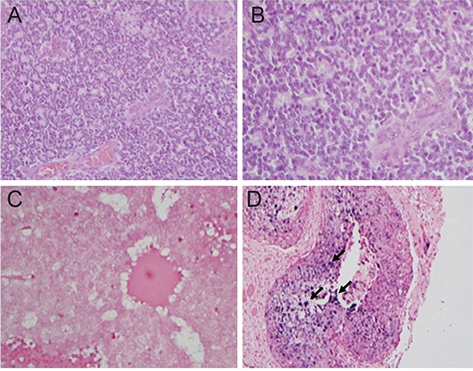Korean J Ophthalmol.
2013 Oct;27(5):368-371. 10.3341/kjo.2013.27.5.368.
Human Papilloma Virus in Retinoblastoma Tissues from Korean Patients
- Affiliations
-
- 1Department of Ophthalmology, Seoul National University College of Medicine, Seoul, Korea. hokyung214@gmail.com
- 2Department of Pathology, Seoul Metropolitan Government-Seoul National University Boramae Medical Center, Seoul, Korea.
- 3Department of Ophthalmology, Seoul Metropolitan Government-Seoul National University Boramae Medical Center, Seoul, Korea.
- 4Department of Ophthalmology, Seoul National University Bundang Hospital, Seongnam, Korea.
- 5Department of Ophthalmology, Hanllym University Sacred Heart Hospital, Anyang, Korea.
- 6Department of Ophthalmology, Seoul National University Hospital, Seoul, Korea.
- KMID: 1707291
- DOI: http://doi.org/10.3341/kjo.2013.27.5.368
Abstract
- PURPOSE
Recent reports suggest the association of human papilloma virus (HPV) with retinoblastoma. This study was performed to elucidate whether HPV infection is related to retinoblastoma among Koreans.
METHODS
A total of 54 cases diagnosed with retinoblastoma were enrolled from Seoul National University Children's Hospital and Seoul Metropolitan Government-Seoul National University Boramae Medical Center. Presence of human papilloma viral DNA was detected by in situ hybridization in formalin-fixed paraffin-embedded retinoblastoma tissues using both probes against high- and low risk HPV types.
RESULTS
The mean age at diagnosis was 22.0 months (range, 1.1 to 98.0 months), and the mean age at enucleation was 27.8 months (range, 1.5 to 112.7 months) among the 54 patients with retinoblastoma. HPV was not detected in any of the retinoblastoma samples using either high risk or low risk HPV probes.
CONCLUSIONS
Our study, being the first study in the Korean population, proposes that HPV infection may have no causal relationship with retinoblastoma in Koreans.
MeSH Terms
-
Child, Preschool
DNA, Viral/*analysis
Eye Infections, Viral/complications/diagnosis/*epidemiology
Female
Humans
In Situ Hybridization
Incidence
Infant
Male
Papillomaviridae/*genetics
Papillomavirus Infections/complications/diagnosis/*epidemiology
Prevalence
Prognosis
Republic of Korea/epidemiology
Retinal Neoplasms/complications/pathology/*virology
Retinoblastoma/pathology/*virology
DNA, Viral
Figure
Reference
-
1. Zur Hausen H. Papillomaviruses causing cancer: evasion from host-cell control in early events in carcinogenesis. J Natl Cancer Inst. 2000; 92:690–698.2. Forman D, Newell DG, Fullerton F, et al. Association between infection with Helicobacter pylori and risk of gastric cancer: evidence from a prospective investigation. BMJ. 1991; 302:1302–1305.3. Choung HK, Kim YA, Lee MJ, et al. Multigene methylation analysis of ocular adnexal MALT lymphoma and their relationship to Chlamydophila psittaci infection and clinical characteristics in South Korea. Invest Ophthalmol Vis Sci. 2012; 53:1928–1935.4. Dimaras H, Kimani K, Dimba EA, et al. Retinoblastoma. Lancet. 2012; 379:1436–1446.5. Anand B, Ramesh C, Appaji L, et al. Prevalence of high-risk human papillomavirus genotypes in retinoblastoma. Br J Ophthalmol. 2011; 95:1014–1018.6. Shetty OA, Naresh KN, Banavali SD, et al. Evidence for the presence of high risk human papillomavirus in retinoblastoma tissue from nonfamilial retinoblastoma in developing countries. Pediatr Blood Cancer. 2012; 58:185–190.7. Gillison ML, Chen R, Goshu E, et al. Human retinoblastoma is not caused by known pRb-inactivating human DNA tumor viruses. Int J Cancer. 2007; 120:1482–1490.8. Mohan A, Venkatesan N, Kandalam M, et al. Detection of human papillomavirus DNA in retinoblastoma samples: a preliminary study. J Pediatr Hematol Oncol. 2009; 31:8–13.9. Antoneli CB, Ribeiro KB, Sredni ST, et al. Low prevalence of HPV in Brazilian children with retinoblastoma. J Med Virol. 2011; 83:115–118.10. Palazzi MA, Yunes JA, Cardinalli IA, et al. Detection of oncogenic human papillomavirus in sporadic retinoblastoma. Acta Ophthalmol Scand. 2003; 81:396–398.11. Lee EH, Um TH, Chi HS, et al. Prevalence and distribution of human papillomavirus infection in Korean women as determined by restriction fragment mass polymorphism assay. J Korean Med Sci. 2012; 27:1091–1097.12. Deodhar K, Gheit T, Vaccarella S, et al. Prevalence of human papillomavirus types in cervical lesions from women in rural Western India. J Med Virol. 2012; 84:1054–1060.13. Vinodhini K, Shanmughapriya S, Sanmugham S, et al. Prevalence of high-risk HPV and associated risk factors in cases of cervical carcinoma in Tamil Nadu, India. Int J Gynaecol Obstet. 2012; 119:253–256.14. Schlecht NF, Brandwein-Gensler M, Nuovo GJ, et al. A comparison of clinically utilized human papillomavirus detection methods in head and neck cancer. Mod Pathol. 2011; 24:1295–1305.15. Jung ES, Shin JH, Lee KJ, et al. HPV in situ hybridization and immunohistochemical expression of L1 capsid protein in cervical intraepithelial neoplasia. Korean J Obstet Gynecol. 2009; 52:1279–1286.16. Jordan RC, Lingen MW, Perez-Ordonez B, et al. Validation of methods for oropharyngeal cancer HPV status determination in US cooperative group trials. Am J Surg Pathol. 2012; 36:945–954.17. Zur Hausen H. Immortalization of human cells and their malignant conversion by high risk human papillomavirus genotypes. Semin Cancer Biol. 1999; 9:405–411.18. Venuti A, Paolini F. HPV detection methods in head and neck cancer. Head Neck Pathol. 2012; 6 Suppl 1:S63–S74.19. Rayess H, Wang MB, Srivatsan ES. Cellular senescence and tumor suppressor gene p16. Int J Cancer. 2012; 130:1715–1725.
- Full Text Links
- Actions
-
Cited
- CITED
-
- Close
- Share
- Similar articles
-
- Complete Remission of Recalcitrant Plantar Wart Treated with Quadrivalent Human Papilloma Virus Vaccine
- Immunohistochemical study on the expression of matrix metalloproteinase 2 and high-risk human papilloma virus in the malignant progression of papillomas
- Detection of Human Papillomavirus DNA in Genital and Laryngeal Papilloma Using the Polymerase Chain Reaction
- Human Papilloma Virus Positive Oropharyngeal Cancer
- Effects of Human Papilloma Virus on related Education for Female High School Students


